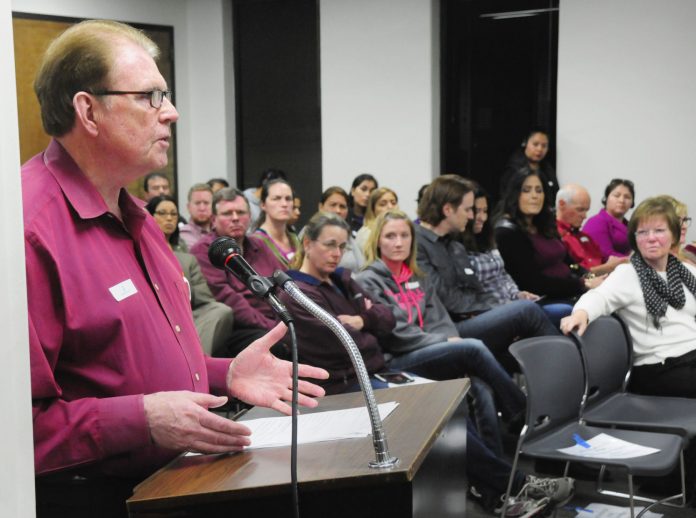
Local school district leaders are stuck between a rock and a hard place when it comes to finding required classroom space for a new charter school looking to expand its operations for the 2016-17 school year.
And Morgan Hill Unified School District’s only solution to the lingering problem—which would place Voices Academy on the same isolated and aging campus as Charter School of Morgan Hill—has infuriated parents, faculty and officials from both charter school organizations.
Superintendent Steve Betando recently toured each potential MHUSD school site to survey the available space and said the district is left with little choice but to convert CSMH’s old multi-use building into classroom space to satisfy the Proposition 39 facilities requests submitted by Voices and CSMH. The district paid an architecture firm $77,600 to assess the structure and recommend renovation or the purchase of portable classrooms to place on the site.
“I did take time to meet with all the principals and tour the sites and look at rooms,” Betando said. “Every single site did not have current available classes to put Voices. It was the same story at each elementary school.”
Opponents of the district’s decision—which has to be finalized by an April 1 deadline—cited dilapidated portables, crumbling restrooms, inadequate parking, poor traffic flow for pickup/dropoff and simply no classroom space as reasons why a shared campus was not feasible at the district’s northernmost school site about 10 miles out of town.
“Have you given any thought to how adding another school will impact CSMH? Seems like the only thought you’ve given is how to torture charter,” said CSMH parent Arthur Kilinski. “I’d rather you guys just come out and say, ‘We really hate all charter schools.’ That would be the only honest and transparent action that you have demonstrated in your time on the board.”
Other parents, such as Elizabeth Spicer who has a 7-year-old attending Voices, stressed the economic hardship it would place on the most needy Voices families who are “already struggling to make ends meet.” Voices is a dual immersion school that caters to a predominantly Hispanic student population.
“In addition to the extra cost of transporting students to this distant campus, parents of students will be less able to participate in afterschool programming both on and off campus,” Spizer noted.
CSMH Principal Paige Cisewski did not take to the podium but wrote in an email to parents: “We support charter schools and Voices, in particular, and would be agreeable to sharing our facility if we had space. However, CSMH feels our site is already not sufficient in size or condition and by placing Voices on our campus only exacerbates this disparity.”
However, district staff stressed there is no easy fix to this complicated dilemma since each of its existing school sites that house elementary-aged students (either K-5 or K-8) face similar space limitations. Plus, earlier this month, the school board told district staff to forget about offering a split-site option to Voices and rejected the notion of putting a second dual immersion program on the same campus in San Martin.
“This is an extremely difficult decision,” said Trustee Ron Woolf, who liked another possible scenario of paying for portable classrooms to place at Voices’ current location at Advent Lutheran Church off Murphy Avenue.
However, Voices would need a conditional use permit from the city to allow for that type of addition to the private property where they hold only an expiring one-year lease. Also, Board President Bob Benevento was not a fan of using public dollars to build on the private church property.
While the district provided a list of shared benefits of having Voices and CSMH on the same campus, including the use of the new Measure G-funded $5 million multipurpose gymnasium, Betando and staff also explained that this would be only a one-year, short-term gap filler until Voices procures land to build its own school for the 2017-18 year. Under Prop 39, the district is required to provide facilities to Voices, as long as the school has not acquired its own site.
Additionally, if the old multi-use building is converted into five classrooms, CSMH would gain access to a couple next year, and the rest once Voices left after only one school year.
“I was absolutely shocked when I saw the proposal to put (Voices) at the CSMH,” Trustee Gino Borgioli said. “CSMH was absolutely the wrong decision in my opinion.”
District evaluated many options for Voices
The final decision in the Prop 39 process between MHUSD and Voices comes after months of back-and-forth negotiations between the two parties. In its initial November filing, Voices requested space at the Adult Education site (formerly Central High School) closer to downtown on Monterey Road, and suggested that there was space available at El Toro Elementary School on Main Avenue.
Another option, which was briefly considered, was the old Burnett Elementary School on Tilton Avenue that houses Central and is called the Loritta Bonfante Education Center. District staff shot those ideas down, not wanting to be responsible for placing elementary school kids on the same grounds as high school or adult education students. In the case of El Toro, staff said it was not true that the site had excess classrooms.
“I think no matter what, let’s take that one off the table, putting Voices with CSMH,” said Trustee David Gerard, who was in favor of the “in lieu” option of keeping the charter at its current church location for another year by adding two portables. “I just want to encourage all the parties to really work together.”
After the district sends its final of the use of CSMH or another district facility by April 1, Voices has until May 1 to accept or deny it. However, signs point to the latter, since Voices’ founding principal Frances Teso called the CSMH idea “not an option that we can take seriously” in a letter read aloud by one of the school’s parents at Tuesday’s meeting. Teso was unable to attend.
Expecting a surplus of CSMH and Voices supporters to come out for the March 15 meeting, district officials took extra measures by setting up closed circuit televisions to view the board proceedings from two other locations at the 15600 district headquarters.







